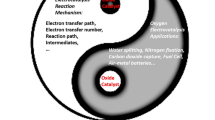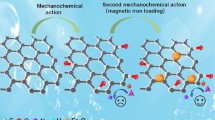Abstract
The behavior of porous titanium and electrodes based on it, which are activated with Pt, Au, RuO2, Co3O4, and MnO2, in 20-% LiCl solution (pH –0.4 to –0.5) is studied. On porous titanium in the potential ranges 0.1 < E< 0.5 and 0.5 < E< 1.1 V (NHE), the formation of titanium hydrides and passive oxide layers, respectively, is observed; the processes decay with time. In the ranges E< 0.1 and E> 1.1 V, the dissolved oxygen reduction and chlorine evolution, respectively, are observed on porous titanium at high overpotentials. On porous titanium activated with thin-layer Pt, Au, and RuO2coatings, the functional Evs. pH dependence, which is typical for these electrocatalysts, breaks down due to the conjugate reactions of titanium oxidation. On porous titanium activated with Co3O4and MnO2, at pH below unity, chlorine evolution is observed; its rate is limited by the chlorine mass transfer into the bulk solution. Under a gas-diffusion control, the chlorine evolution rate is determined by the diffusion of absorbed hydrogen chloride. The conditions of application of porous titanium as the support for catalytically active electrodes of electrochemical sensors in acidic chloride solutions are considered.
Similar content being viewed by others
REFERENCES
Levinskii, M.I., Mazanko, A.F., and Novikov, I.N., Khloristyi vodorod i solyanaya kislota (Hydrogen Chloride and Hydrochloric Acid), Moscow: Khimiya, 1985.
Sbornik zakonodatel'nykh, normativnykh i metodicheskikh dokumentov dlya ekspertizy vozdukho-okhrannykh meropriyatii (Collection of Regulations on the Examination of Air Conservation Measures), Leningrad: Gidrometeoizdat, 1986.
Goepel, W., Hesse, I., and Zemel, I.N., Comprehensive Survey in Eight Volumes, Berlin: VCH, 1991, vol. 2.
Kinoshita, K. and Madau, M.I., J. Electrochem. Soc., 1984, vol. 131, p. 1089.
Shmatko, A.G. and Voronina, I.V., Elektrokhimiya, 1992, vol. 27, p. 1098.
Sensoric. Gesellschaft fuer Angewandte Elektrochemie mbH. Issue 02/96.
Kal'voda, R., Zyka, Ya., and Shtulik, K., Elektroanaliticheskie metody v kontrole okruzhayushchei sredy (Electroanalytical Methods in the Environmental Monitoring), Moscow: Khimiya, 1990.
Spravochnik po elektrokhimii (A Handbook on Electrochemistry), Sukhotin, A.M., Ed., Leningrad: Khimiya, 1981.
Spravochnik khimika (A Handbook on Chemistry), Nikol'skii, B.P. et al., Eds., Leningrad: Khimiya, 1964, vol. 3, p. 204.
Pourbaix, M., Atlas d'Equilibres Electrochimiques, Paris: Gauthier-Villars, 1963.
Yakimenko, L.M., Elektrodnye materialy v prikladnoi elektrokhimii (Electrode Materials in Applied Electrochemistry), Moscow: Khimiya, 1977.
Korovin, N.V. and Kasatkin, E.V., Elektrokhimiya, 1993, vol. 29, p. 448.
Fokin, M.N., Ruskol, Yu.S., and Mosolov, A.V., Titan i ego splavy v khimicheskoi promyshlennosti (Application of Titanium and Its Alloys in the Chemical Industry), Leningrad: Khimiya, 1978.
Gladysheva, T.D., Archakov, O.V., and Podlovchenko, B.I., Elektrokhimiya, 1995, vol. 31, p. 566.
Vetter, K. and Yeager, N., in Osnovnye voprosy sovremennoi teoreticheskoi elektrokhimii (Basic Problems in Modern Theoretical Electrochemistry), Frumkin, A.N., Ed., Moscow: Mir, 1965.
Kokarev, G.A., Kolesnikov, V.A., Gubin, A.F., and Korobanov, A.A., Elektrokhimiya, 1982, vol. 18, p. 407.
Fogg, A. and Buck, R.P., Sens. Actuators, 1984, vol. 5, p. 137.
Lyamina, L.I., Tarasova, N.M., and Gorbunova, K.M., Elektrokhimiya, 1979, vol. 15, p. 1605.
Lyamina, L.I., Tarasova, N.M., and Gorbunova, K.M., Elektrokhimiya, 1985, vol. 21, p. 957.
Reiman, L.V., Tekhnika mikrodozirovaniya gazov: Spravochnik (Techniques of Gas Microdosing: A Handbook), Leningrad: Khimiya, 1985.
USSR Inventor's Certificate no. 1762214, Byull. Izobret., 1992, no. 34.
Fioshin, M.Ya. and Smirnova, M.G., Elektrokhimicheskie sistemy v sinteze khimicheskikh produktov (Electrochemical Systems in Chemical Syntheses), Moscow: Khimiya, 1985.
Gamburg, Yu.D., Elektrokhimicheskaya kristallizatsiya metallov i splavov (Electrochemical Crystallization of Metals and Alloys), Moscow: Yanus-K, 1997, p. 93.
Bodoardo, S., Brenet, J., Maja, M., and Spinelli, P., Electochim. Acta, 1994, vol. 39, p. 1999.
Petrii, O.A., Electrochim. Acta, 1996, vol. 41, p. 2307.
Ruetschi, P., J. Electrochem. Soc., 1998, vol. 135, p. 2657.
Author information
Authors and Affiliations
Rights and permissions
About this article
Cite this article
Chviruk, V.P., Zaverach, E.M. & Linyucheva, O.V. Behavior of Porous Titanium and Catalytically Active Electrodes Based on It in Acidic Chloride Solutions. Russian Journal of Electrochemistry 37, 512–517 (2001). https://doi.org/10.1023/A:1016680221868
Issue Date:
DOI: https://doi.org/10.1023/A:1016680221868




